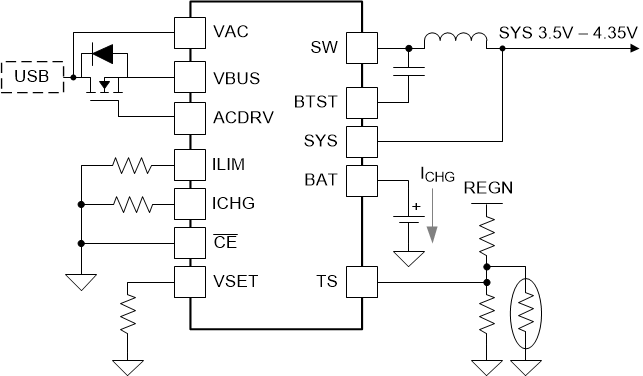SLUSDF7A January 2020 – February 2022 BQ25616
PRODUCTION DATA
- 1 Features
- 2 Applications
- 3 Description
- 4 Revision History
- 5 Description (continued)
- 6 Device Comparison Table
- 7 Pin Configuration and Functions
- 8 Specifications
-
9 Detailed Description
- 9.1 Overview
- 9.2 Functional Block Diagram
- 9.3
Feature Description
- 9.3.1 Power-On-Reset (POR)
- 9.3.2 Device Power Up From Battery Without Input Source
- 9.3.3 Power Up From Input Source
- 9.3.4 Boost Mode Operation From Battery
- 9.3.5 Standalone Charger
- 9.3.6 Power Path Management
- 9.3.7 Battery Charging Management
- 9.3.8 Status Outputs ( PG, STAT)
- 9.3.9 Protections
- 9.4 Device Functional Modes
- 10Application and Implementation
- 11Power Supply Recommendations
- 12Layout
- 13Device and Documentation Support
- 14Mechanical, Packaging, and Orderable Information
3 Description
The BQ25616/616J is a highly integrated 3-A switch-mode battery charge management and system power path management device for single cell Li-Ion and Li-polymer batteries. The solution is highly integrated with input reverse-blocking FET (RBFET, Q1), high-side switching FET (HSFET, Q2), low-side switching FET (LSFET, Q3), and battery FET (BATFET, Q4) between system and battery. The low impedance power path optimizes switch-mode operation efficiency, reduces battery charging time and extends battery run time during discharging phase.
The BQ25616/616J is a highly integrated 3-A switch-mode battery charge management and system Power Path management device for Li-ion and Li-polymer batteries. It features fast charging with high input voltage support for a wide range of applications including speakers, industrial, and medical portable devices. Its low impedance power path optimizes switch-mode operation efficiency, reduces battery charging time, and extends battery run time during discharging phase. Its input voltage and current regulation deliver maximum charging power to the battery.
| PART NUMBER | PACKAGE(1) | BODY SIZE (NOM) |
|---|---|---|
| BQ25616/616J | WQFN (24) | 4.00 mm × 4.00 mm |
 Simplified
Application
Simplified
Application